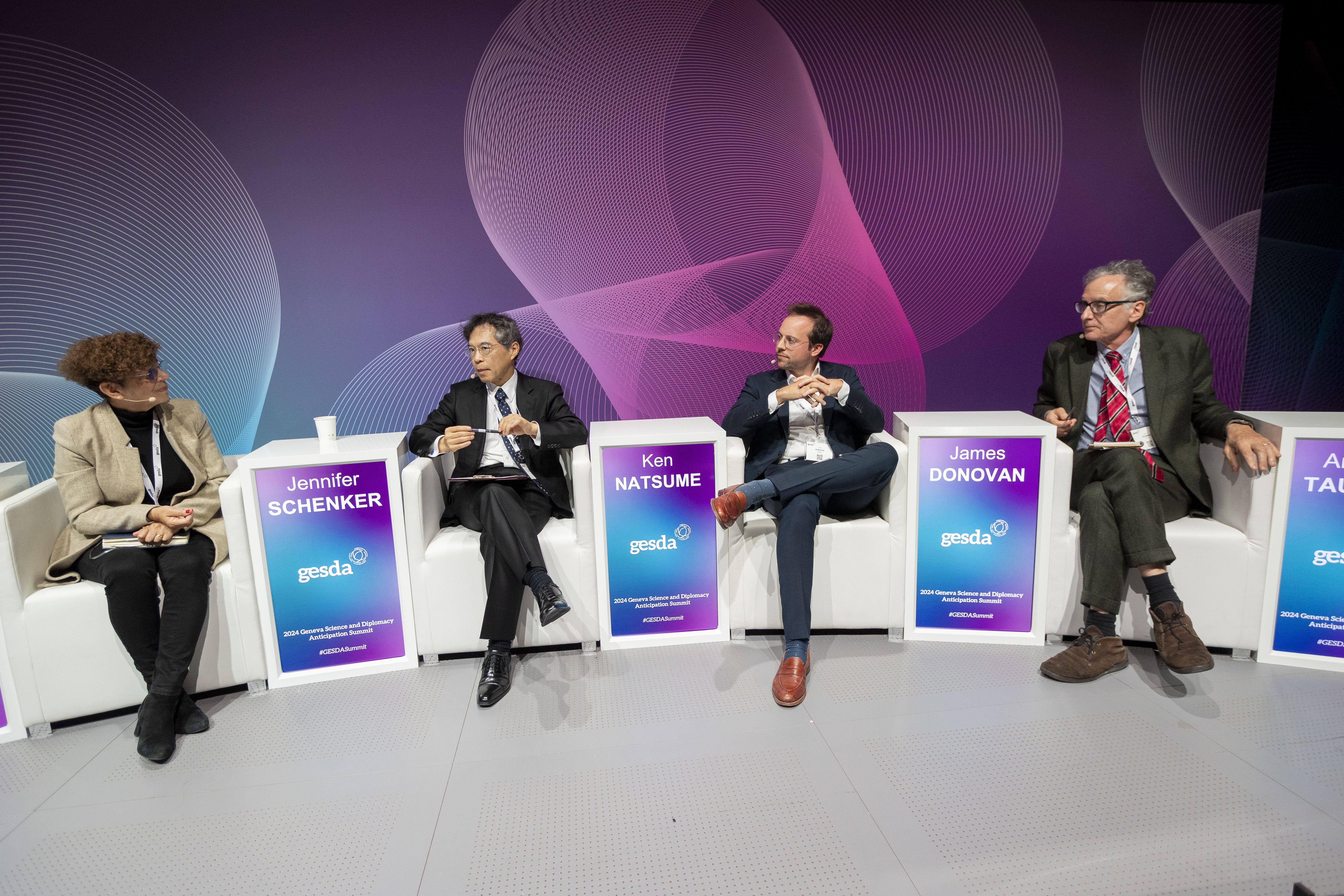As technology continues to accelerate scientific breakthroughs and patent creation, the tension between the human right to benefit from science and technology and the rights of creators to protect their work is intensifying. How can we design future protection models that strike a balance between innovation, access, and fairness in a rapidly evolving technological landscape? The panel of experts in law and technology explored how intellectual property (IP) can evolve to meet these challenges. This report summarizes the key ideas shared by the speakers along with insights from the audience.
The following is the rapporteur report of an expert discussion held during the 2024 GESDA Summit. The author is a Villars Fellow.
Ideas from the Speakers
The Human Right to Science
The speaker emphasized the concept of the human right to science, asserting that everyone should have the opportunity to participate in and benefit from scientific progress. She acknowledged that while IP is crucial for promoting innovation, it often comes into conflict with this right. She proposed several strategies to help realign IP systems with scientific goals:
- utility: limit IP protection to inventions with clear industrial applications
- exclusion: clearly define what is and is not protected by IP
- exception: introduce mechanisms to diminish IP-related barriers and enhance access to scientific knowledge
- expiration: reevaluate the current 20-year duration of IP protections
The speaker concluded that these adjustments could help achieve a better balance between the rights of creators and the broader public interest in scientific progress. She also stressed the need to expand the scope of IP beyond legal and economic frameworks and to be more inclusive, cooperative and flexible, especially in considering who benefits.
Accelerating Science through Artificial Intelligence
Another speaker discussed the need to accelerate scientific development through artificial intelligence (AI) while maintaining equity and safety. He argued that AI can diversify scientific methodologies and expand access for researchers. He emphasized the importance of fine-tuning IP frameworks to keep pace with these changes, particularly in balancing risk and reward. If AI contributes to major breakthroughs, he maintained that credit should go to the scientists using AI rather than solely to the AI developers, since the scientists are the ones actively using the tool and guiding the inquiry. As AI increases access to scientists and scientific knowledge, the speaker advocated for licensing agreements that preserve and enhance that openness rather than restrict it.
He also called for greater clarity between foundational and applied research, and suggested creating incentives that support a range of research approaches aimed at preventing the concentration of power and knowledge in the hands of a few actors.
WIPO’s Role in International Consensus
A speaker discussed how the World Intellectual Property Organization (WIPO) is addressing the challenges posed by generative AI. He highlighted WIPO’s efforts to include the perspectives of various stakeholders, including the public, academia, and experts, to build international consensus on IP rights in this evolving area. He emphasized the complexities surrounding copyright for AI-generated content and the need for global collaboration to ensure that IP frameworks benefit a wide range of stakeholders, especially developing countries and younger generations.
The speaker also outlined two prevailing views of how credit should be assigned in the use of AI:
- The user of AI deserves recognition for the creativity involved in crafting prompts that shape the AI’s output.
- The AI itself acts as a “black-box” that autonomously generates content and, hence, should be credited for the output.
Recalibrating IP
A speaker examined whether AI’s access is intensifying tensions between IP rights and the right to science. He argued that IP should be viewed as a tool rather than an absolute right, one that must be recalibrated to reflect evolving circumstances. He raised fundamental questions about the nature of invention, asking whether AI should be recognized as an inventor. He stressed the importance of returning to the core principles of IP, while also taking into consideration moral rights and the implications of AI-generated works. He expressed hope that AI would serve as a tool to disseminate knowledge and foster collaboration rather than hinder progress.
Insights from the Audience
The session included several key takeaways:
Balancing access and protection: Striking the right balance between open access and the protection of IP is vital to cultivate a more inclusive scientific community.
The importance of collaboration: Collaboration between members of academia, industry leaders, and policymakers is crucial. Diverse viewpoints play a role in shaping effective IP frameworks.
The future of IP: IP laws must evolve in response to technological advances. The idea of recognizing AI as an inventor and creating new protections for AI-generated content sparked interest among attendees.
Ethical considerations: Ethical concerns, particularly pertaining to the monopolization of knowledge and its potential impact on developing nations, were raised. Establishing ethical guidelines to govern AI’s role in research and innovation is critical.
To conclude, the panel emphasized the urgent need to adapt IP frameworks to a fast-evolving scientific landscape shaped by AI. Striking a balance between innovation, access and fairness will require inclusive models that uphold the human right to science and prevent the monopolization of knowledge.







